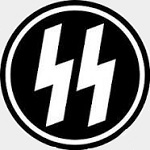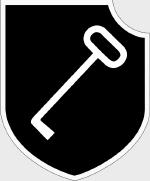Dragon DRR60146 German Sd. Kfz. 181 PzKpfw VI Tiger I Ausf. E Heavy Tank - SS-Hauptsturmfuhrer Michael Wittmann, "Black 1331", schwere SS Panzerabteilung 101, 1.SS Panzer Division "LSSAH", Operation Zitadelle, Kursk, Russia, 1943 (1:72 Scale)
"The gun and armor of the Tiger were superb, making it in many ways the most formidable tank in service. Even so, it was poor in maneuver, it was slow, and its turret was a slow traverser in action. It was a tank which was, at its best, immobile in ambush, when its killing power was very frightening."
- Douglas Orgill, "German Armor"
 The German Waffenamt issued an order to design the VK4501(H) (as the PzKpfw VI Ausf. E was then known) in May 1941, just one month prior to the commencement of Operation Barbarossa. Interestingly, Henschel und Sohn of Kassel was charged with building the heavily armored chassis while Krupp, by far the largest munitionwerks in Germany, was given the task of developing the turret. The PzKpfw VI Ausfuhrung E (type E) was one of the first German tanks to feature a torsion bar with eight interleaved wheels, which was designed to support the weight of the mammoth 57-ton tank. The Ausf. E mounted a huge 8.8cm KwK36 L/56 cannon and featured two MG34 machine guns for close support against enemy infantry. By war's end, 1,354 vehicles had been produced, some rolling off the Wegmann assembly line.
The German Waffenamt issued an order to design the VK4501(H) (as the PzKpfw VI Ausf. E was then known) in May 1941, just one month prior to the commencement of Operation Barbarossa. Interestingly, Henschel und Sohn of Kassel was charged with building the heavily armored chassis while Krupp, by far the largest munitionwerks in Germany, was given the task of developing the turret. The PzKpfw VI Ausfuhrung E (type E) was one of the first German tanks to feature a torsion bar with eight interleaved wheels, which was designed to support the weight of the mammoth 57-ton tank. The Ausf. E mounted a huge 8.8cm KwK36 L/56 cannon and featured two MG34 machine guns for close support against enemy infantry. By war's end, 1,354 vehicles had been produced, some rolling off the Wegmann assembly line.
This particular 1:72 scale early production Tiger I Ausf. E heavy tank, was led by Michael Wittmann of the 1st SS Panzer Division (Leibstandarte Adolf Hitler), which saw action at the Battle of Kursk during Operation Zitadelle. Vehicle sits atop a real grass diorama and features a tank commander standing in the turret. Comes packed in an attractive display tin complete with numbered certificate of authenticity.
Sold Out!
Dimensions:
Length: 4-1/2-inches
Width: 2-1/4-inches
Release Date: April 2005
 Historical Account: "On to Oblivion" - While Michael Wittman and his crew had already earned a reputation for cunning and bravery, it was perhaps During Operation Zitadelle (The Battle for Kursk) that he passed from feared adversary into immortal legend. Early in the afternoon of the first day of operations, Wittmann heard over the radio that another platoon of Tiger tanks was under attack by a number of Soviet T34s. He immediately changed direction of his attack, passing through a nearby wooded area so he and his platoon could outflank a line of enemy anti-tank guns. This maneuver also enabled them to approach from the rear the same Soviet tanks that were still engaging the beleaguered Tigers. While two of his Tigers engaged the anti-tank guns, Wittmann and his crew swung into action -- within minutes they systematically destroyed three Russian tanks, thus saving his comrades from almost certain destruction.
Historical Account: "On to Oblivion" - While Michael Wittman and his crew had already earned a reputation for cunning and bravery, it was perhaps During Operation Zitadelle (The Battle for Kursk) that he passed from feared adversary into immortal legend. Early in the afternoon of the first day of operations, Wittmann heard over the radio that another platoon of Tiger tanks was under attack by a number of Soviet T34s. He immediately changed direction of his attack, passing through a nearby wooded area so he and his platoon could outflank a line of enemy anti-tank guns. This maneuver also enabled them to approach from the rear the same Soviet tanks that were still engaging the beleaguered Tigers. While two of his Tigers engaged the anti-tank guns, Wittmann and his crew swung into action -- within minutes they systematically destroyed three Russian tanks, thus saving his comrades from almost certain destruction.
Soon afterwards, his vehicle lost a track after striking a Russian pressure mine. The Divisions' efficient workshop quickly had it running again, and by the end of the day Wittmann and his crew had destroyed a total of eight enemy tanks and seven anti-tank guns. It has been claimed that his individual efforts had helped
II SS Panzer Korps drive a salient 20km deep into the positions held by the Russian 52nd Guards Infantry Division. Although the campaign was disastrous for both the 1. SS Panzer Division and Wehrmacht as a whole, during the 10 days of fighting from July 4th to the 13th, Michael Wittmann and his crew had destroyed 30 enemy tanks and knocked out a further 32 anti-tank guns. For this and other feats, he would eventually be awarded the coveted Knight's Cross.









